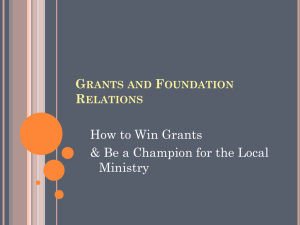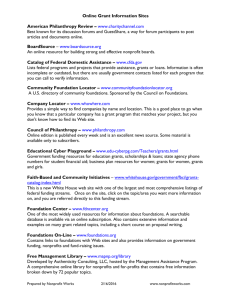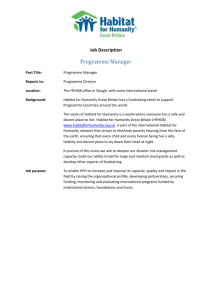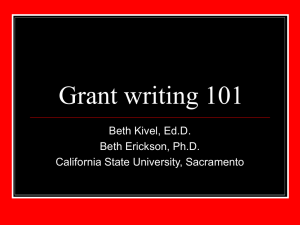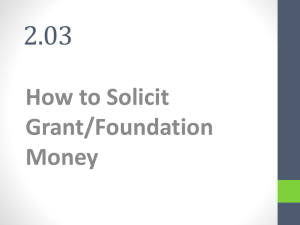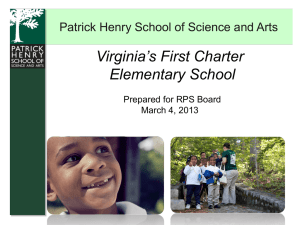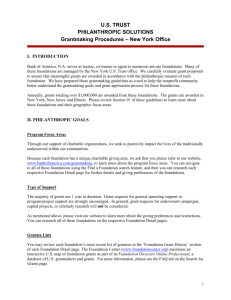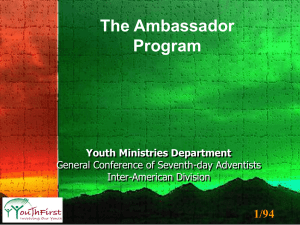Archdiocese of Los Angeles Department of Catholic Schools
advertisement
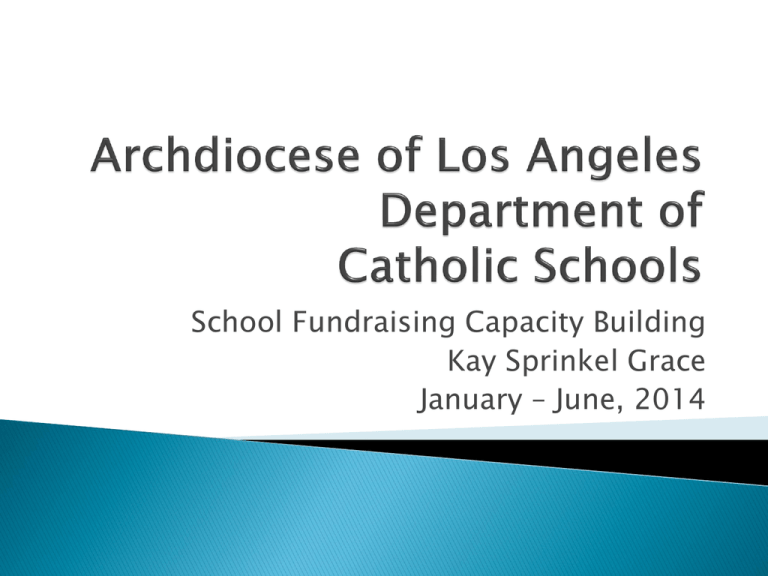
School Fundraising Capacity Building Kay Sprinkel Grace January – June, 2014 Grant Writing and Techniques for Growing Foundation Investment April 8 @3:30 – 4:30 p.m.; April 29 @ 7 – 8 p.m. Review of assigned work: volunteer job description and foundation identification worksheet Foundation funding and overall support for nonprofit sector (Giving USA) Understanding the Foundation world Basics of grant writing Getting grants out: what does it take? Resources for Foundation grants Summary of session Homework for Webinar #5 3 Types of Foundations The good and bad and ins and outs of Foundation funding Easiest grant makers to research They are the “venture capitalists” of the nonprofit world: can give big money and can give “PRIs” (program related investments) Grants are likely to be only for one year, but some will commit for a longer period When the stock market is “red hot” (like it is now) foundation assets soar More and more foundations are addressing a select area of issues (e.g., women and girls, hunger, homelessness, poverty, etc.) 7 Grant is usually for a finite period of time and a definite purpose Guidelines change with trends and emerging needs in communities Operating grants hard to get: will fund a piece of your overall work, one whose impact can be measured Most foundation grants go to public education, health, human services and culture Religious organizations receive a small percentage of foundation funds 8 “Private foundations established to provide support or distributions to tax-exempt organizations through grants.” (IRS) Must give away at least 5% of the value of their assets each year Usually established through gifts from individuals or families; often carry the names of the original funders (e.g., Ford, Packard, Carnegie) “Family foundations” are a type of independent foundation where giving decisions involve living family members Staff size varies with asset base and distribution activity 9 Also considered “private” foundations Receive assets from an associated for-profit company or business (e.g., Exxon-Mobil, AT&T) Often serve as grant making vehicle for company May have a separate board from the corporation/company Decisions influenced by employee involvement and by alignment of corporate interest and nonprofit purpose and mission Staffing varies according to funding activity 10 They look for the WIIFM – “What’s in it for me?” Many may not be able to fund religious organizations, particularly if they are public companies that have not included religious organizations in their basic foundation documents Exceptions may be made when there is a strong relationship between high-level personnel in the corporation and your school 11 Assets are growing at twice the rate of independent/private or corporate foundations They receive gifts and make gifts (e.g., California Foundation, Ventura County Community Foundation, others in southern California) As a public charity, they must receive assets from a large pool of donors and consequently fund a wide range of community needs Most community foundations limit their interests and grants to a particular geographical area Growth is due to rise in asset values for individual donors and the growth in donoradvised funds (70% between 2008 and 2012) 12 Community foundations have unrestricted funds, donor-advised funds and donordesignated funds Donor-advised and donor-designated funds are permanent gifts to the community foundation and provide an immediate tax deduction to the donor Staffing varies according to the number of donor-advised/designated funds Related structure: Catholic Education Fund, Hispanic Education Foundation 13 Tax benefit is given when the gift is made into the foundation – there is no urgency to push it out into the community Community Foundations and other donoradvised funds are hesitant to connect you with their donors (respecting privacy) Money flows out at a rate of 16% to 17% a year (and there are more than $13 billion under management in donor advised funds) BUT – 70% of donors follow their “personal values” when giving, so it is worth it to try 14 Find a connection to the DAFs Excite donors about your plans Emphasize your vision Engage the donor in cultivation Promote your impact and value proposition Seldom make grants to other nonprofit organizations Dedicated to conducting research and promoting programs to support the work of the original charter or governing body IRS requires them to spend at least 85% of their income in support of their own programs (e.g., Gates) Serve as conveners and may provide opportunities to connect with others 16 Operational/unrestricted ◦ No conditions for use Program ◦ Specific set of activities and plans Capital ◦ Building construction funds, equipment, endowment growth Pilot/Seed ◦ Start up programs, projects or organizations Challenge or matching ◦ To encourage other philanthropic giving 17 Higher expectations, more accountability Emphasis on evaluation: grantees often must submit an evaluation plan Collaboration with other organizations focusing on the same or similar mission is encouraged More clearly defined guidelines and application processes 18 Charitable gift funds at (e.g., Schwab, Fidelity, Vanguard) have huge increases in managed assets and advise donors and manage donoradvised funds Expectation that an organization’s board and other volunteers will reflect the diversity of the community Support for capacity building, which waned during the recession, is growing again but usually only for organizations already receiving support from the foundation 19 From what kinds of foundations have you received support and for what purposes? ◦ Independent (private, family, other) ◦ Corporate ◦ Community ◦ ◦ ◦ ◦ ◦ Operations Program Capital/endowment Pilot Challenge grant 20 Getting ready to approach Making a request 21 Be able to show evidence of diverse financial sources – the foundation grant should be one part of a fully diversified development plan Research the foundation to determine any linkages and interest, and make sure your priorities are reflected in a strategic plan Be sure your project or program is within their guidelines and the impact can be measured Like individual fundraising, successful foundation partnerships are built on trusted relationships established over time 23 Ask three questions (Hank Rosso’s advice): ◦ Is there a previous relationship with the school through funding or friends? ◦ What size is the typical gift? Total assets? ◦ Is the foundation interested in this program? Check the foundation’s 990 and other research Adhere to the guidelines: if you fall within their guidelines, proceed ◦ Make an initial phone call (some will not accept unsolicited calls so you may need to prepare a brief letter of inquiry that outlines the parameters and benefits of the program but no budget – yet) 24 Assemble a proposal package ◦ ◦ ◦ ◦ ◦ ◦ ◦ ◦ ◦ Cover sheet including contact information Executive summary of proposal Identification of needs statement Case expression (Webinar #2) covering the problem/issue Proposed solution (program or project) List of outcomes Evaluation tool(s) Description/list of governance and staffing Budget and budget explanation Package should be reviewed and approved by Principal and/or Archdiocese personnel before submission 25 Get broad input on ideas and positioning, but have only one person write the proposal (a camel, remember, is a horse designed by a committee!) Draw from your case materials, and create a proposal (a proposal is a case expression) You must include all the information they ask for, or the proposal will not be considered 26 Observe deadlines and don’t ask for exceptions or extensions Over time, create a proposal template that can be revised according to the funder’s guidelines – it is part of the “systems liberate” idea Work with the foundation program officer who has asked you to submit; it is better to ask questions and do it right than to submit and have it rejected 27 Review and decision process 28 Received and reviewed to make sure there are no missing materials (most submitted now via Internet and you are given a checklist) Verification it is within foundation funding guidelines and has followed the submission format or template Sent to program officer for evaluation of alignment with foundation priorities If there is interest, you may be called to arrange a site visit – engage your Ambassadors and Advocates at that visit 29 Foundation officers recommend proposals to the foundation’s board (and/or Distribution Committee) – Proposals are sent out to them prior to their meeting At the meeting, they are discussed and decisions are made If you are funded, it is the beginning, not the end, of the relationship (just like with an individual) 30 You must extend immediate and appropriate thanks and mutually agreed to recognition (donor listing, press release, etc.) Your success is important to the foundation and will influence future funding Ongoing evaluation begins, and periodic reports are filed If you are having trouble implementing, let them know ASAP If you are denied, try to keep the relationship going – you never know when it might work 31 Your goal is to have a diversified funding base Foundations will want assurance they are not “supporting you” entirely Foundation funding is robust right now, but during the recession it was not Individuals are still our strongest and largest gift source, especially for religious organizations including schools Foundations are a key part of a healthy fundraising program 32 Primary resource for research and support 33 http://foundationcenter.org/ -- The Foundation Center is the best resource both online and through their 400+ Cooperating Collections in every state and Puerto Rico http://maps.foundationcenter.org/cc/CCUS.php (interactive map with locations including LA area which has several sites – e.g., VCCF) The Foundation Center operates five free libraries: California’s is in San Francisco For Catholic education supporters, and particularly in Southern California, use your online search engine with key words 34 There are several types of foundations: each has its plus and minus factors The trends in foundation funding parallel all funding trends: accountability, metrics, etc. Gather wide input for a proposal then assign to one person to write Foundations are part of a diversified funding program The Foundation Center is the “go to” resource for new sources or to revalidate your base 35 Webinar #5 will be the long-awaited “Creating, Implementing and Growing an Annual Fund at Your School” To get ready for that session, please finish your case elements checklist, be sure your mission/vision/values statements are refreshed and discussed with your volunteers, and complete the foundation identification assignment from Webinar #3 for Webinar #4 – you will need all of those things in place in order to run an effective annual fund. 36 All you need to do to get ready for #5 is to get together for a one hour meeting and lay out a brief plan for your annual fund including ideas about: ◦ Messaging ◦ Structure, including volunteers and staff and involvement of classrooms ◦ Who you will reach out to for participation ◦ The financial goal you have set and what it is based on ◦ What percentage of your overall fundraising goal is your annual fund? 37 May 6 @ 7 – 8 p.m.; May 20 @ 3:30 – 4:30 p.m. 38 School Fundraising Capacity Building Kay Sprinkel Grace January – June, 2014
